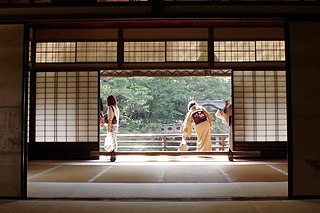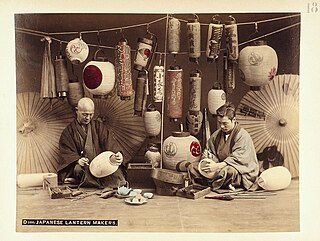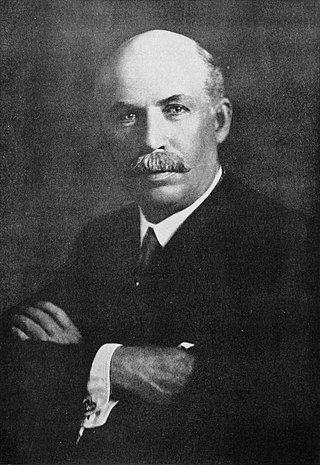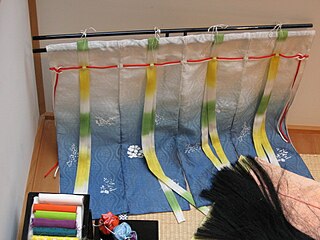Related Research Articles

Samuel Finley Breese Morse was an American inventor and painter. After establishing his reputation as a portrait painter, Morse, in his middle age, contributed to the invention of a single-wire telegraph system based on European telegraphs. He was a co-developer of Morse code in 1837 and helped to develop the commercial use of telegraphy.

A shoji is a door, window or room divider used in traditional Japanese architecture, consisting of translucent sheets on a lattice frame. Where light transmission is not needed, the similar but opaque fusuma is used. Shoji usually slide, but may occasionally be hung or hinged, especially in more rustic styles.

Edward Sylvester Morse was an American zoologist, archaeologist, and orientalist. He is considered the "Father of Japanese archaeology."

Japanese carpentry was developed more than a millennium ago that is known for its ability to create everything from temples to houses to tea houses to furniture by wood with the use of few nails.

An engawa (縁側/掾側) or en (縁) is an edging strip of non-tatami-matted flooring in Japanese architecture, usually wood or bamboo. The en may run around the rooms, on the outside of the building, in which case they resemble a porch or sunroom.

The traditional lighting equipment of Japan includes the andon (行灯), the bonbori (雪洞), the chōchin (提灯), and the tōrō (灯篭).

Takamine Hideo was an administrator and educator in Meiji period Japan.

The Banggai crow is a member of the crow family from Banggai regency in the province of Central Sulawesi in Indonesia. It is listed as critically endangered by IUCN. It was feared extinct, but was finally rediscovered during surveys on Peleng Island off the southeast coast of Sulawesi by Indonesian ornithologist Mochamad Indrawan in 2007 and 2008.

The Peabody Museum of Salem (1915–1992), formerly the Peabody Academy of Science (1865–1915), was a museum and antiquarian society based in Salem, Massachusetts. The academy was organized in part as a successor to the East India Marine Society, which had become moribund but held a large collection of maritime materials in a museum collection at the East India Marine Hall, built in 1825 on Essex Street. The Peabody Museum was merged with the Essex Institute to form the Peabody Essex Museum in 1992. The East India Marine Hall, now embedded within the latter's modern structure, was designated a National Historic Landmark in 1965 in recognition of this heritage, which represents the nation's oldest continuously-operating museum collection.

A chōzubachi (手水鉢), or water bowl, is a vessel used to rinse the hands in Japanese temples, shrines and gardens. Usually made of stone, it plays an important role in the tea ceremony. Guests use it to wash their hands before entering the tearoom, a practice originally adapted from the custom of rinsing one’s mouth and cleansing one’s body in the chōzuya before entering the sacred precincts of a Shinto shrine or a Buddhist temple.

Sukiya-zukuri (数寄屋造り) is one type of Japanese residential architectural style. Suki means refined, well cultivated taste and delight in elegant pursuits, and refers to enjoyment of the exquisitely performed tea ceremony.

Edward Phinley Morse was a Canadian-American industrialist and proprietor of the Morse Dry Dock and Repair Company, a major turn of the 20th century ship repair facility located in Brooklyn, New York. He later assisted in the creation of United Dry Docks, Inc., a corporation formed by the merger of six New York-based ship repair companies including his own, and at the time the largest corporation of its type in the world.

A kichō (几帳) is a portable multi-paneled silk partition supported by a T-pole. It came into use in aristocratic households during and following the Heian period (794–1185) in Japan when it became a standard piece of furniture. Kichō are similar in appearance to a kabeshiro, but are mounted on a free-standing stand rather than a lintel beam. They are less similar to noren, which do not include streamers to tie them up, and are generally used in different social settings.
The following is a timeline of the history of the city of Mobile, Alabama, USA.

The Hangang Railway Bridge (Korean: 한강철교) crosses the Han River in Seoul, South Korea and connects Noryangjin Station and Yongsan Station. It was the first permanent crossing on the Han River.

Allen Benton Morse was an American diplomat, jurist and politician.
The following is a timeline of the history of the city of Wilmington, Delaware, USA.

A tsuitate (衝立) is a form of single-panel portable partition traditionally used in Japan since at least the 6th century. They may be made of wood, or a wood frame covered in paper or silk cloth. The panels are often illustrated, with paintings on both sides, sometimes by well-known artists. The wood frame may be lacquered, and pricier tsuitate may be very richly decorated, including use of precious metals.
The James Gordon Bennett was a 19th-century two-masted pilot boat, built in 1870 at the Lawrence & Foulks shipyard. She was named in honor of James Gordon Bennett, Jr., publisher of the New York Herald. She went ashore in 1893 and was rebuilt at the C. & R. Poillon shipyard. In 1897, the James Gordon Bennett was bought by Miller J. Morse of the Atlantic Yacht Club and made into a yacht. He changed her name to Hermit. The New Jersey pilots purchased her in 1901, to replace the David T. Leahy, that was run down by the steamship Alene. The Hermit sank in 1906, when the steamship Monterey ran into her.
References
- Morse, Edward S. (1885). Japanese Homes and their Surroundings. Charles E. Tuttle Company. ISBN 0-8048-0998-4.